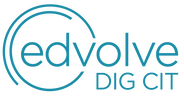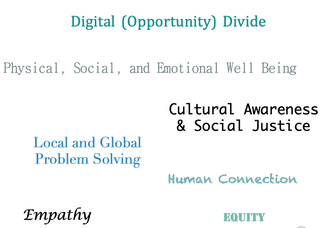|
Digital Citizenship hasn't always been the "hot topic" that it is today. In fact, it wasn't so long ago that I would visit higher ed classrooms and ask pre-service teachers what they knew about it... and the resounding answer was *crickets.* I'll never forget one class, circa 2013, in which a young man who was studying to be a secondary English teacher told me, "I've never heard of digital citizenship, but if I had to take a guess, I'd say maybe it's an online course you can take to become a U.S. citizen." But a lot has changed in the past few years... digital citizenship seems to be on everyone's mind (it's "cool"!) and there's been forward movement in both policy & practice. Today, there are hashtags, symposiums, institutes, books, and conferences dedicated to dig cit; it is pronounced in ISTE's standards; more schools & districts are making it a priority. Image Source: https://pixabay.com/en/graphic-smiley-emoticon-cool-3731034/ As I reflect back on the dig cit landscape over the past 15+ years, I realize how much has changed... not only its growth in popularity, but also a huge shift in content and delivery. The following is my attempt to narrate the digital citizenship evolution from:
The EvolutionFrom what I've been able to ascertain, the term "digital citizenship" can be tracked to around 2000. But it became more well-used, at least in ed tech circles, around 2004 when ISTE published an article in Learning & Leading with Technology, entitled “Digital Citizenship: Addressing Appropriate Technology Behavior” (Ribble, Bailey, & Ross, 2004). I view the Digital Citizenship 1.0 period from about 2000 - 2015, give or take, according to the state, region, district, school, individual educator... you get the picture. In the early 2000s, more and more students began using technology. I have clear memories of students in various grade levels clamoring to use the 5 computers in the back of the room to research their chosen state/animal/country, to print their word processed stories, or create PowerPoint presentations with images and information about a given topic. As more students began to use the computers, educators began to see & understand the new issues (read: problems) that could ensue. Enter the scene, digital citizenship. The name of the game? Manage. Risk. We (read: Educators) were all scrambling a bit to define the problems that could occur and cut them off at the knees. We had heard of adult predators lurking on the Internet and drawing kids in, so Online Stranger Danger became an area of focus (safety). As did keeping kids away from porn sites and ensuring adherence to "Netiquette" (legality & responsibility). Side note: when was the last time you used the term "netiquette"?! Dig Cit 1.0 was reactionary and the primary goal was to "keep kids away from the bad stuff." The tone was teacher (adult) centered and geared toward student compliance. This may seem negative by today's standard... but at the time, it's just where we were at. But slowly, things have changed!! And, the shift to Digital Citizenship 2.0 has been significant. And awesome. Dig cit innovators began making this shift around 2014-ish. Since then, the "new digital citizenship" has appealed to more and more educators, hence its increase in presence & popularity! Simply put, the evolution to Digital Citizenship 2.0 is defined by a more positive, opportunity-based position on digital use.
Influencing the 2.0 Shift The International Society of Technology in Education (ISTE) is the authoritative organization (read: mothership) for technology-using teachers, leaders, and coaches. ISTE recently refreshed their student standards (2016), educator standards (2017), and leader standards (2018) with language that exquisitely reflects a positive, opportunity-based, student-empowered perspective. This has been one of, if not THE leading influence for the 2.0 shift to empowerment & opportunity. If you're not familiar with ISTE's standards, I highly encourage you to make it a priority. The #ISTEStandards are gold! And here's the point in this blog post where you might take a moment to reflect on your own views of digital citizenship & how you talk about it with your students (or kiddos, if you're reading as a parent). Are conversations & rules based in fear or opportunity? Do students/kids believe that technology is something to avoid, or something to embrace? Do they know how to "use the force for good"? Many educators I've spoken to are somewhere in the middle between 1.0 to 2.0. What about you? Digital Citizenship 3.0 is about the future. Another shift. Because as long as life in the digital age evolves, so will digital citizenship. Dig Cit 3.0 looks forward to new ways of viewing technology and our ever-evolving relationship with it. Even with all the positive shifts in Dig Cit 2.0, there's still more to explore and uncover*. Consider the following topics, as they relate to technology use and citizenship in the digital world. As we continue to peel away layers of the Digital Citizenship onion, let's consider two additional lenses for our engagement with technology: PERSONAL FULFILLMENT and SOCIETAL CONTRIBUTIONS. While we continue to empower students, let's also re-examine implications of technology use, with new eyes. At the heart of this shift, should lie Authenticity, Awareness, and Action. Personal Fulfillment/Personal Best How do I become the best version of myself? How do I fulfill my potential? What do these questions mean in the context of our digital landscape? How can we empower students to this end? What role can technology play? Relationships, human connection, and positive decision-making are components of social-emotional learning... What happens when we fold technology into that? What happens when we don't? Empowering students and developing their agency for learning also contribute to helping students fulfill their potential. Technology can increase and amplify opportunities for students to develop skills and mindsets for lifelong learning. Societal Contributions/Social Good How can we leave this world better than how we found it? What does equity mean in the context of our digital world? When we identify as citizens of local and global communities, we are naturally curious... about our fellow community members, community celebrations, traditions, and challenges. As we become more deeply rooted, we are often compelled to take part in improving conditions for the citizens of the community. Technology, on one hand, is a lever for community participation. On the other hand, it also exacerbates a divide that results in inequitable opportunities. How can we, as educators, help students to participate in communities, encourage empathy, and address disparities in healthy & productive ways? If you've made it through this entire thing, congratulations and thank you (It was a long one!) This blog post has been rolling around inside of me for about 6 months and today it just kind of all poured out. I would love to hear how you're thinking about digital citizenship and what new questions are emerging in your conversations as/with educators, students, and parents! This conversation will never be "finished" because it evolves as does technology and our lives as technology users. I look forward to co-constructing and evolving digital citizenship with YOU! Cheers, LeeAnn
1 Comment
Leave a Reply. |
AuthorI care deeply about helping educators cultivate healthy environments where every student and teacher can learn, grow, and thrive in this digital world! |







 RSS Feed
RSS Feed
